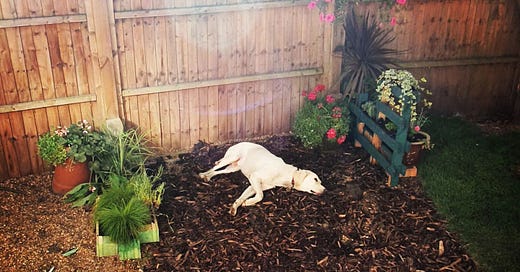From the outside in: Teaching Bruno an inside cue to manage his garden reactivity
After working hard on getting Bruno to leave the house, his reactivity to my neighbours meant I had to start training him to run inside when he saw them...
As happy as I was that Bruno had now stopped doing his daily dump on my hallway rug, his thrice daily trips out to the garden to empty his bowel and bladder was a rather fraught affair for me.
This was because Bruno had started making a nuisance of himself by barking and running at the fence whenever he heard or saw any of my neighbours outside in their gardens.
Whenever this happened, I’d shout an apology over the fence, usher him inside, and then bide my time before letting him out there again to relieve himself.
I always used to check the coast was clear before letting him out there, but there was no way of knowing when one of them might get overcome by the urge to hang out their washing or take the bins out.
So, as Bruno took his sweet time deliberating over which one of my pot plants to poison next with his piddle, I’d anxiously scan the fence line for any signs that one of my neighbours might be heading outside.
My anxiety was borne out of fear that Bruno and I were at risk of being labelled nuisance neighbours, on account of his anti-social behaviour. I also knew there was a danger the more he practised this behaviour, the more ingrained it would become - and the harder it would be to train out of him.
Also, it’s very hard to train a behaviour out of a dog when you can’t predict when the thing triggering it will happen.
In an ideal world, I’d desensitise Bruno to the coming and goings of my neighbours using classical conditioning techniques, where you pair a scary thing happening (neighbour pops out) with something good (treats) to change his emotional response to it.
Timing is everything when you’re training something like this and there is usually less than a second separating the scary thing happening and Bruno’s reaction to it, meaning there is next to no time to treat him at the appropriate time.
Also, for that to be successful, there needs to be enough distance between him and the scary thing so that he can survey it from afar without triggering his fight or flight response. Because once that happens his brain will have flipped from learning and processing mode to one focused solely on survival.
What you definitely don’t want to happen is that the scary thing happens, Bruno reacts (barks and lunges) and then he gets a treat. Because then you are rewarding him for being a barky menace, and dogs are more likely to repeat behaviours that pay well.
So I decided to focus instead on leaning into his survival response – specifically his propensity for flight – by teaching him that when the scary thing appears in his environment, he could just run away from it. Rather than waste his time and energy running at it, in the hope of scaring it away, he could just remove himself from the situation by responding to my “inside” cue.
To start this process, I started “charging” the word “inside” by saying it to him and then giving him a treat. So he started to pair the word with good things happening to him. We’d do this for 3-4 minutes each day, in the house, where there were no distractions.
Within a few days, saying the word “inside” would (more often than not) get you his undivided attention. But that’s not the behaviour I was looking for. I wanted him to hear the word and know it meant, “go inside the house”.
So, first thing in the morning (which was usually the time we were least likely to encounter any of my neighbours), I’d let Bruno out in the garden to sniff about and do his business. Once that delicate matter was taken care of, I’d leave him to potter about for a moment or two. Then, when he was looking nice and relaxed, I’d get his attention by saying the cue word before chucking his treats inside the back door for him to retrieve. Once he’d trotted in after them, I’d follow and shut the door behind us.
After a few weeks of practice and repetition, Bruno would immediately run indoors when I said the word “inside”, which is amazing and was – at the time – a most welcome development.
As previously mentioned, I was aware that teaching Bruno to run inside when he was scared of something wasn’t doing anything to address his underlying fear. I needed to work to change his emotional response from a negative to a positive one whenever he saw my neighbours. But at least the inside cue would buy us a little bit of time to work on that...




